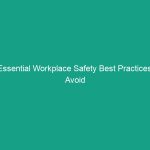Good Morning Team!
Today, we are diving into an incredibly important topic: Essential Confined Space Attendant Duties: Monitoring and Communication Tips. Understanding the role of a confined space attendant is crucial for ensuring our Safety and the Safety of our colleagues while working in potentially hazardous environments.
Confined spaces can pose serious risks, and it’s vital that everyone on our team is familiar with the attendant’s duties to mitigate these risks effectively. Let’s explore what you need to know!
Understanding Essential Confined Space Attendant Duties
A confined space attendant is responsible for monitoring the safety of workers in confined spaces and ensuring effective communication between the workers inside and the outside team. The roles and responsibilities of a confined space attendant are not just important; they are essential for preventing accidents and ensuring compliance with safety Regulations.
Many employees might think that being an attendant is a passive role, but it is anything but that! Attendants are the first line of defense against Hazards that may arise in confined spaces. They are tasked with monitoring conditions and communicating vital information effectively to ensure everyone’s safety.
Key Hazards, Risks, and Safety Considerations
When working in confined spaces, there are several hazards to be aware of:
- Oxygen Deficiency: The atmosphere may lack sufficient oxygen, leading to asphyxiation.
- Flammable Atmospheres: Accumulation of flammable gases or vapors can result in explosions.
- Toxic Substances: Exposure to harmful chemicals can happen rapidly in enclosed areas.
- Engulfment: Workers can become engulfed in materials like sand or grain.
Ignoring these hazards can lead to severe injuries or fatalities. For instance, consider the case of a worker who lost consciousness due to insufficient oxygen levels, highlighting the critical need for vigilant monitoring and quick communication.
Best Practices, Procedures, & Actionable Advice
Monitoring Techniques
As a confined space attendant, your primary duty is to monitor the atmosphere and the safety of workers. Here are some Best Practices to follow:
- Regular Atmospheric Testing: Always conduct pre-entry and continuous monitoring of the confined space atmosphere using calibrated gas detectors.
- Use of Personal Protective Equipment (PPE): Ensure all workers have the necessary PPE based on the risks identified.
- Check Communication Devices: Verify that all communication equipment is functioning before entry.
Communication Tips
Effective communication is vital in maintaining safety in confined spaces. Here are some strategies:
- Establish Clear Signals: Before entry, agree on verbal and non-verbal signals to communicate emergencies.
- Maintain a Constant Dialogue: Use two-way radios or other devices to check in regularly with workers inside.
- Document Everything: Keep a log of all communications, monitoring readings, and any incidents that occur.
Steps to Follow
Follow these steps to ensure a safe Operation:
- Conduct a thorough risk assessment.
- Prepare the confined space and ensure all Safety Measures are in place.
- Communicate all hazards and emergency Procedures to the team.
- Monitor continuously and be prepared to respond to any situation.
Regulations, Standards, and Compliance
Compliance with safety regulations is non-negotiable. Familiarize yourself with the following:
- OSHA Standards: Be aware of osha’s confined space regulations which dictate the requirements for confined space entry.
- Company Policies: Always adhere to our company’s specific safety protocols and procedures.
Understanding these regulations is critical not just for compliance but for the overall safety of our workforce. Non-compliance can lead to hefty fines and, more importantly, endanger lives.
Employee Engagement & Discussion
Let’s take a moment to discuss your thoughts and experiences. Here are a few questions to consider:
- What safety challenges have you encountered in confined spaces?
- How can we improve our monitoring and communication strategies?
- What additional Training or resources do you think would help us be safer?
Your feedback is invaluable, and discussing these points will help us strengthen our safety culture.
Conclusion & Key Takeaways
In conclusion, the role of a confined space attendant is vital for maintaining safety in our workplace. Remember to:
- Conduct continuous monitoring of the Environment.
- Communicate effectively and regularly.
- Follow all safety regulations diligently.
By applying these practices, we can ensure a safer working environment for everyone. Thank you for your attention today and for your commitment to safety. Let’s make it our priority every day!


